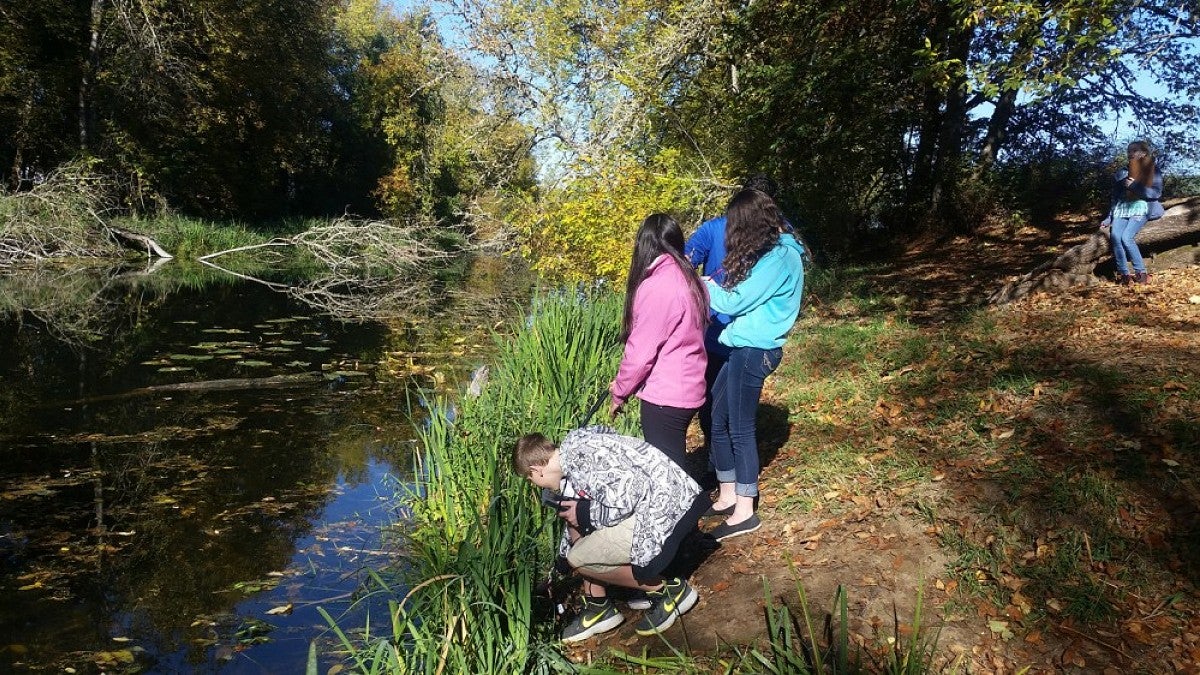For hundreds of elementary- and middle-schoolers in Lane County, daydreams of thrilling outdoor exploration during class are now a reality: That’s a crucial part of their math and science education, thanks to new teaching standards nationwide.
Forty Lane County school teachers — teaching third through eighth grade — are partnering with the University of Oregon and local community organizations in an effort to provide more science, technology, engineering and math education, also known as STEM classes. The classes reach students through project-based studies, which often involve a driving question, student choice of material and a public audience for their findings.
The partnership is made possible by a grant awarded to the UO by the Oregon Department of Education and funded by the United States Department of Education through the Elementary and Secondary Education Act.
Throughout the academic year, local teachers participate in the university’s grant-funded course focused on math and science project-based teaching. In the class, teachers work with university faculty to develop lesson plans and class projects — called Content in Context SuperLessons, or C2SL — that focus on addressing open-ended questions that involve real-world problems.
Fifteen teachers enrolled in the course last February, immediately after the UO received the grant, and another 25 teachers joined them in August for the current academic year. The teachers come from seven out of 16 school districts in Lane County.
“The course is providing opportunities for me to learn about the new standards, as well as the time to develop lessons that match these new standards,” said Carrie Patterson, a math and science teacher at Agnes Stewart Middle School in Springfield. “I hope I’m able to develop lessons that capture students’ interest and give them opportunities to think, discuss and do science so they can develop a strong understanding of the basic processes that are at work in our world.”
As part of the course, the UO also facilitates a partnership between teachers from the school district and representatives from community organizations, including the Eugene Water and Electric Board, BRING Recycling, Lunar Logic, PeaceHealth Laboratories and several other groups who come to classrooms and help lead math and science projects.
“We’ve created a model where we’re not just drawing on our faculty here, but partnering with the community as well,” said Bryan Rebar, associate director of the STEM CORE Program at the UO. “The focus (of the lessons) is primarily on project-based teaching, but also on Common Core and Next Generation Science Standards. We know that teachers need training around these new standards; we’re trying to support math- and science-based teaching together, as well as professional teacher development.”
With the new standards in place, project-based math and science teaching has become the norm in Lane County. With the projects, there’s a specific focus on authenticity and a connection to real-world professions.
“We don’t want students to say, ‘We can’t do math, this is science class,’” Rebar said. “We’re pushing teachers to break out of the mold of traditional teaching and (see that) every single standard is no longer built around some fact, it’s a performance expectation — using the same practices that scientists and professionals use in their everyday work.”
Utilizing their Content in Context SuperLessons, teachers are getting students outside to explore nature, facilitating meetings with community organizations during class visits and taking field trips all over the state so students can get the practical experience they need to fully engage with the academic material.
One of the projects, led by Patterson, was recently featured by the Springfield School District on their website.
Around 180 seventh-graders at Agnes Stewart Middle School are answering the question, “How can we as students educate the public about the value of our local natural area?” through projects scheduled throughout the academic year. They’ve been exploring the wetlands around their school and learning about different topics related to natural resources in the area — topics like preservation of native plants and animals, restoring the Mill Race, park planning and the science behind water quality issues.
“This type of hands-on exploration of the natural world is exactly the direction we want to go in Springfield,” said Springfield schools Superintendent Sue Rieke-Smith in the article. “The students are learning the critical thinking skills they will need in the real world.”
— By Nathaniel Brown, Public Affairs Communications


